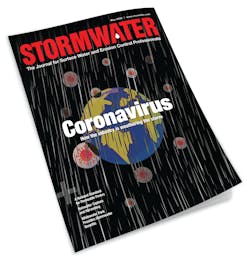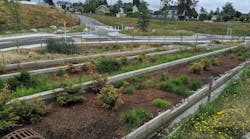For many of us, the last month has felt like a year. As I write, we’re still in the midst of the national and global coronavirus pandemic, with the number of cases and deaths still growing. I’ve been working from my living room for over a month now, and I’m not alone—many conversations I’ve had recently with industry professionals, contributors, and colleagues have covered the challenges of adjusting to working from home and emails I receive routinely end with “Stay healthy.”
But beyond the personal, how is this pandemic affecting the industry? Those who work in the stormwater and erosion control industry are a diverse group, comprising academics, contractors, regulators, manufacturers, and consultants. Some will transition to working from home relatively easily and some will not. Some work outdoors where it’s easier to social distance and some don’t. And, as the situation changes almost daily, there are certainly new challenges ahead.
For a snapshot of the stormwater and erosion control industry at the beginning of the US COVID-19 pandemic, we reached out to professionals around the country to hear how they are being affected. In “Weathering the Storm,” we discuss how they are handling social distancing requirements, funding concerns, and a situation that changes continually. We’re reminded to find hope in community and the value and resiliency of this industry.
Despite how it can sometimes feel, the virus isn’t all that’s going on. In “Permeable Paving Standards,” David R. Smith, the technical director of the Interlocking Concrete Pavement Institute, covers ASCE’s recent national standard for permeable interlocking concrete pavement. We also have a follow up to last month’s Q&A, this time with two minority- and women-owned stormwater construction businesses that participated in the Mentor-Protégé Program that is part of Prince George’s County’s Clean Water Partnership.
Finally, check out the two unique case studies we’ve brought you in this issue. In Colorado, a whitewater rafting park provides both a unique opportunity for outdoor recreation and enhanced flood control and stormwater management (“A Whitewater Adventure”). And in “Saving a Rainy Day,” Dr. Kathy Gee examines a rainwater harvesting and capture system that allowed a site in Minnesota to meet stormwater goals and reduce demands on local potable water sources.
As I adjust to working through a pandemic, I am reminded by the hardworking people in this industry that we’re not alone. Stormwater and erosion control professionals continue to complete interesting projects, push the industry forward, and support each other. In the meantime, we at Stormwater will continue to provide you with the content you know and trust.
How has the pandemic affected you and your work? Send an email to [email protected] and share your story.
About the Author
Rachel Sim
Editor
As the editor of Stormwater magazine from June 2019 to December 2020, Rachel Sim created and curated quality content addressing the challenges faced by surface water and erosion control professionals, focusing on cutting-edge technology and the latest environmental research.


